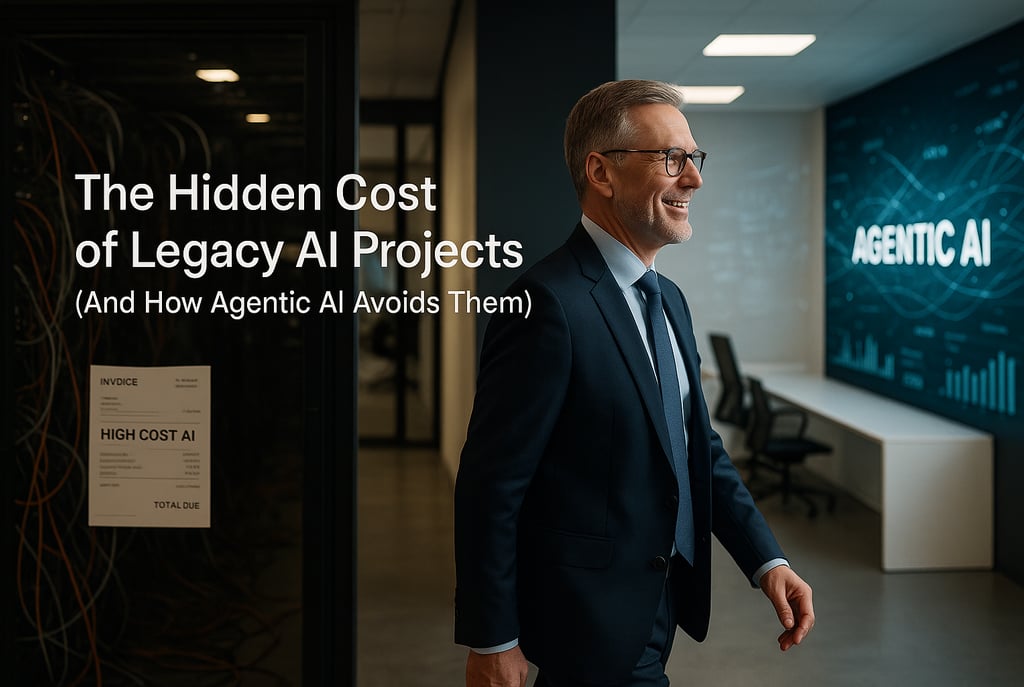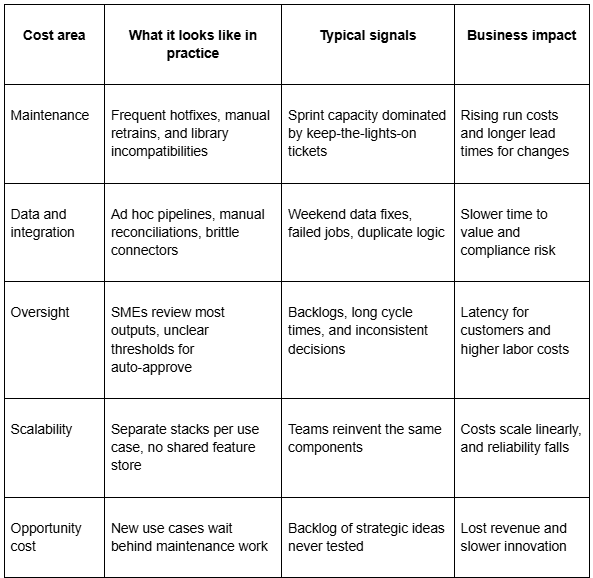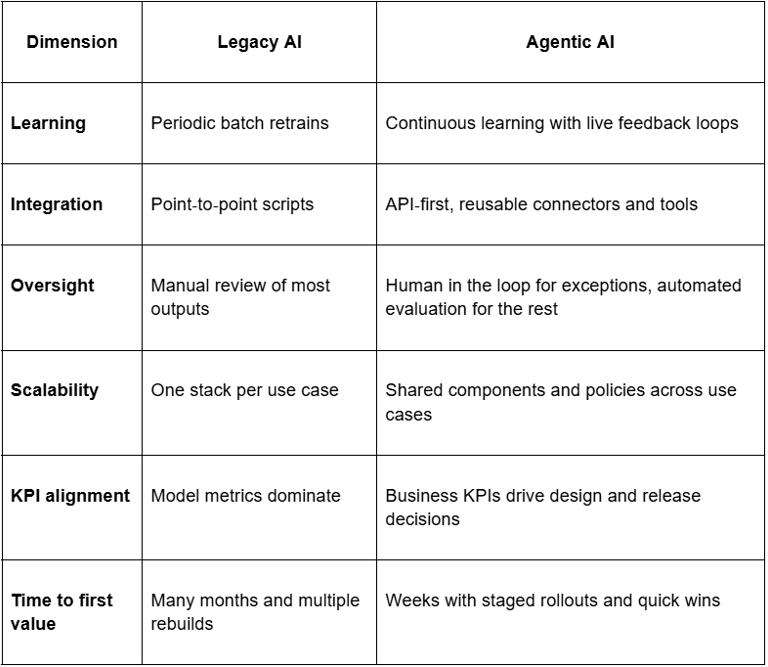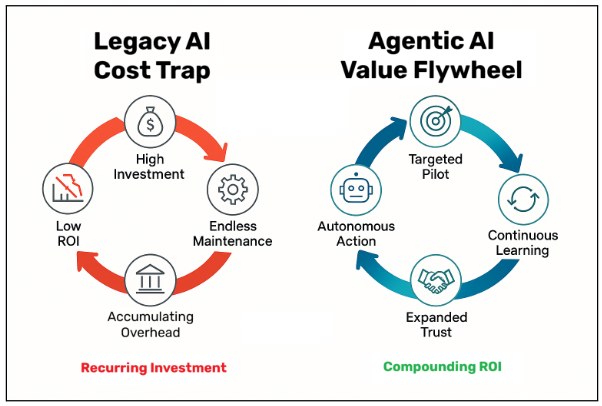The Hidden Cost of Legacy AI Projects (And How Agentic AI Avoids Them)
Know the hidden costs draining legacy AI projects and how Agentic AI can help leaders save millions, while maximizing ROI and business outcomes.
Aishwarya
8/31/20256 min read


You invested in AI to be a competitive advantage. You envisioned streamlined operations, data-driven decisions, and explosive growth. But instead of a strategic asset, you’re managing a money pit: endless maintenance, sky-high talent costs, and rigid systems that can’t adapt to a changing market.
If this feels familiar, you're not alone. Many leaders discover that their legacy AI projects carry a steep, hidden price tag that drains resources and stifles innovation. This isn't a failure of AI's promise, but a failure of a legacy approach. The good news? We are now Agentic AI. They are designed from the ground up to avoid these pitfalls, finally delivering the efficiency and ROI you were promised.
This article reveals:
The specific hidden costs draining your AI project budgets
How legacy infrastructure creates operational bottlenecks
Why agentic AI bypasses traditional system limitations
Practical strategies to transition from legacy AI to Agentic AI successfully.
The Promise vs. Reality of Traditional AI Implementations
As companies invest heavily in AI, the anticipation of transformative benefits often clashes with the harsh realities of implementation. The initial expectations surrounding Traditional AI are high, with many businesses believing it will revolutionize their operations and significantly boost their ROI.
What Companies Expected from AI Investments
Organizations typically expect AI investments to drive efficiency, enhance customer experiences, and provide a competitive edge. They anticipate that AI will help them make data-driven decisions, automate mundane tasks, and uncover new business opportunities.
For instance, a study found that businesses that adopted AI reported a significant increase in productivity. However, the actual implementation process often reveals unforeseen challenges.
The Stark Reality Many Organizations Face
The reality many organizations face is that Traditional AI implementations can be complex, costly, and time-consuming. Integration issues, data quality problems, and the need for specialized talent are common hurdles.
A recent MIT report found that a mere 5% of enterprises have seen significant returns on their generative AI investments, with 95% seeing little to no measurable value. This highlights that most projects fail not from technological limits, but from gaps between expectations and real-world execution.
For example, a financial services company may find that its legacy systems are incompatible with new AI solutions, resulting in significant integration challenges and costs. Such realities often dampen the initial enthusiasm and expected ROI from AI investments.
Defining Legacy AI: What Makes an AI System "Legacy"?
Understanding what constitutes a legacy AI system is crucial for businesses today. As AI technology continues to evolve, companies must recognize the characteristics that define legacy AI to avoid the pitfalls associated with outdated AI implementations.
Technical Characteristics of Legacy AI Systems
Legacy AI systems often exhibit specific technical characteristics that hinder their performance and adaptability. These include:
Outdated algorithms that fail to leverage the latest advancements in machine learning.
Inflexible architectures make it difficult to integrate new data sources or adjust to changing business needs.
Limited scalability, leading to performance issues as the system grows.
Operational Limitations That Define Legacy AI
Beyond technical characteristics, legacy AI systems are also defined by operational limitations. These include:
Difficulty in integrating with modern data ecosystems, leading to data silos and inefficiencies.
Inability to adapt to changing market conditions, resulting in missed opportunities and decreased competitiveness.
High maintenance costs due to the need for continuous updates and patches.
By understanding these characteristics and limitations, businesses can better identify legacy AI systems and take steps to modernize their AI infrastructure, avoiding the hidden costs associated with legacy AI.
The 5 Hidden Costs Of Legacy AI Projects
The financial implications of legacy AI projects extend far beyond the initial investment. While the upfront costs are often well understood, there are several hidden costs that can significantly impact the overall return on investment (ROI) of these projects.
1) Ongoing Maintenance And Technical Debt
Model drift, feature rework, library upgrades, and infrastructure patching add recurring effort.
When retraining requires full rebuilds, support hours grow each quarter.
2) Data Quality And Integration Friction
Data wrangling often consumes the largest share of team time.
Integrations rely on one‑off scripts rather than productized connectors.
3) Human Oversight Burden
SMEs must validate outputs and interpret edge cases.
Review queues create delays and erode the speed advantage AI promised.
4) Scalability Limits
Monolithic designs break when volumes spike or when new sources are added.
Reuse across teams is poor, so costs scale linearly with each new use case.
5) Opportunity Cost Of Delayed Innovation
Talent and budget are tied up keeping yesterday’s system alive.
Teams cannot test higher‑value use cases because they are busy fixing the basics.
The Hidden Costs of Legacy AI


Why Traditional AI Underdelivers On ROI
The underdelivery of ROI in traditional AI projects stems from a combination of technical and strategic missteps. Despite significant investments in AI technology, many organizations fail to realize the expected benefits due to several underlying issues.
Siloed delivery: AI is built as a side project, not a workflow change.
KPI misalignment: Teams optimize precision or recall instead of cost to serve, cycle time, or revenue per customer.
Inflexibility: Every market shift demands new data, new code, and re-approvals.
Governance bolted on late: Risk, privacy, and audit come after the build, which adds manual checks and slows everything down.
Agentic AI: What Changes
Agentic systems couple reasoning with action. Instead of a single model answering a question, agents plan, call tools, read and write to systems, and learn from feedback. The point is not novelty. The point is measurable outcomes with less glue work.
Core design principles
Autonomy within guardrails that the business can observe and tune.
API‑first integration so agents work inside live workflows.
Continuous learning and evaluation, not one‑off retrainings.
KPI‑first design that ties every decision to business outcomes.
Legacy AI vs. Agentic AI At A Glance


How Agentic AI Sidesteps Legacy Pitfalls
Agentic AI is gaining traction for its ability to avoid the pitfalls that have hindered legacy AI projects. Unlike traditional AI systems that are often rigid and difficult to maintain, Agentic AI offers a more adaptable and robust solution.
Adaptive learning instead of static rebuilds
Capture human feedback during use and feed it back into policies and models.
Automate evaluation with test suites that reflect business KPIs.
Reduced dependency on scarce specialists
Standardize prompts, tools, and policies so product teams can ship safely.
Provide self‑serve evaluation reports that business owners can read.
Integration that lasts
Use an AI gateway for tool calling, identity, and audit.
Keep connectors versioned and reusable so changes do not break agents.
Future-proof modular architecture
Separate policy, memory, tools, and model. Swap components without rewrites.
Runbooks define how agents escalate, pause, or seek approval.


Integrating Agentic AI with Legacy Systems: Challenges and Strategies
Transitioning from legacy AI to agentic systems isn’t plug-and-play. Companies face several integration challenges:
Data silos: Disconnected datasets block unified decision-making.
Process rigidity: Legacy workflows can’t easily accommodate autonomous agents.
Security & compliance: New agents must inherit existing controls without breaking regulations.
Strategies for smooth integration:
1. Assessment
Map current AI estate, data flows, and governance.
Quantify hidden costs and backlog burn.
2. Quick wins
Target a narrow, high‑leverage decision path such as invoice exception handling or lead triage.
Stand up a pilot agent with clear acceptance criteria and automated evaluation.
3. Core integration
Introduce an AI gateway, shared feature and memory stores, and an evaluation pipeline.
Replace brittle scripts with reusable connectors.
4. Scale with governance
Roll out playbooks for approval thresholds, incident response, and cost controls.
Expand to adjacent processes using the same components.
Elevin: How We Help You Avoid Hidden Costs of Legacy AI Projects
Elevin builds business-first agentic AI systems that focus on measurable outcomes, safe autonomy, and integration that holds up in production. Here is how we typically engage:
1) Agentic Readiness Audit
Two-week assessment of data flows, integrations, oversight, and cost drivers.
Deliverables: quantified hidden-cost report, prioritized backlog, KPI map.
2) Quick-Win Blueprint
Four-week design and pilot of one agent in a single decision path, such as claims adjudication, collections outreach, RFP response drafting, or order-to-cash exceptions.
Deliverables: working agent, evaluation dashboard, cost-avoidance analysis.
3) Scale-Up Roadmap
Roadmap to expand agentic systems across business lines.
Deliverables: integration plan, governance model, multi-agent orchestration framework.
Want to dive deeper into Agentic AI? Explore leadership-focused insights, strategies, and expert guidance on the Elevin blog.
Future-Proof Your AI Strategy
Legacy AI isn’t failing because AI is broken. It’s failing because of hidden costs and brittle systems. The transition from legacy AI to Agentic AI isn’t just a technology upgrade: it’s a strategic shift.
It’s about building a resilient, adaptable capability that drives continuous growth and protects you from the hidden costs that plague outdated AI systems.
Curious where hidden costs may be draining your AI ROI? Book a readiness audit with us today. We’ll analyze your current challenges and map out a clear path to ROI with Agentic AI
Excellence
Elevin Consulting: Your Partner in Growth.
Impact
© 2025 Elevin Consulting Pvt Ltd. All Rights Reserved
Trust
hello@elevinconsulting.com
